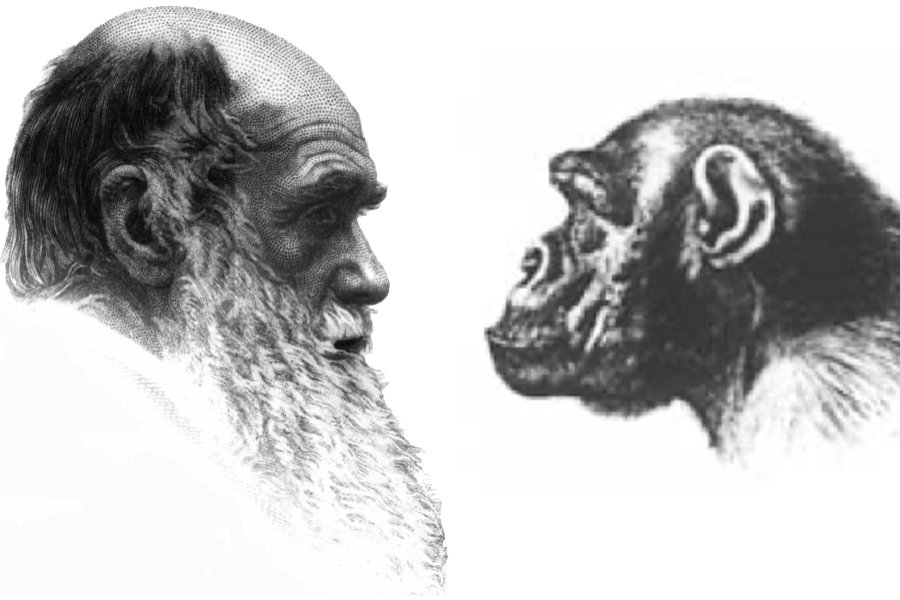

“Almost everything about the basic structure of the Universe… the fundamental laws…of physics and the initial distribution of matter and energy … is balanced on a razor’s edge for life to occur.”
Michael Murray


While conflicted by that “hopeless muddle,” did you ever express concern as to whether your hypothesis was worth the investment of your lifetime?
I “…may have devoted my life to a phantasy [sic].” 36
Can science explain the origin of first life on Planet Earth?
“Science as yet throws no light on the far higher problem of the essence or origin of life.” 2
Can you cite an example of how evolution theory might work in action?
“In North America the black bear was seen by Hearne swimming for hours with widely open mouth, thus catching, like a whale, insects in the water. Even in so extreme a case as this, if the supply of insects were constant, and if better adapted competitors did not already exist in the country, I can see no difficulty in a race of bears being rendered, by natural selection, more and more aquatic in their structure and habits, with larger and larger mouths, till a creature was produced as monstrous as a whale.” 3
Do you allege that all plants, such as a calla lily, and all animals, such as a hummingbird, have evolved from the same primordial ancestor?
“Analogy would lead me…to the belief that all animals and plants have descended from some one prototype…I should infer from analogy that probably all the organic beings which have ever lived on this earth descended from some one primordial form, into which life was first breathed.” 4
Is it true you believe humans share common ancestry with monkeys?
“Man appears to have diverged from the Old World division of the Simiadae, after these had diverged from the New World division.” 5
Describe in detail what you mean by the “Simiadae”!
“The Simiadae…branched off into two great stems; the New World and Old World monkeys; and from the latter, at a remote period, Man, the wonder and glory of the Universe proceeded… 6
Do you claim some “fish-like animal” had a place in human genealogy?”
“All the higher mammals are probably derived from an ancient marsupial, and this through a long line of diversified forms, either from some reptile-like or some amphibian-like creature, and this again from some fish-like animal.” 7
Do you believe water was the natural habitat of human ancestors?
“The progenitors of man must have been aquatic in their habits; for morphology plainly tells us that our lungs consist of a modified swim-bladder…the heart existed as a simple pulsating vessel.” 8
Are you proposing that all vertebrates, including humans, descended from some gender-neutral, single-sex hermaphrodite ancestor?
“Some extremely remote progenitor of the whole vertebrate kingdom appears to have been hermaphrodite or androgynous.” 9
Millions of fossils have been discovered. Can you identify a fossil hermaphrodite that qualifies scientifically as a human ancestor?
“Geological research…does not yield the infinitely many fine gradations between past and present species required on the theory…” 10
Do you have any idea what these early progenitors of man looked like?
“Early progenitors of man were no doubt once covered with hair, both sexes having beards; their ears were pointed and capable of movement, and their bodies were provided with a tail…” 11
If human ancestors had tails, do you think they swung from trees?
“Man is descended from a hairy quadruped, furnished with a tail and pointed ears, probably arboreal in its habits…” 12
Since many species of monkeys still exist, swinging from trees, do you anticipate any chance monkeys will go extinct in the future?
“The production of new forms has caused the extinction of about the same number of old forms.” 13 “We may safely infer that not one living species will transmit its unaltered likeness to a distant futurity.” 14
If men and women descended from the same hermaphrodite ancestor, as you suggest, shouldn’t they be equal in all ways, including brainpower?
“…Man has ultimately become superior to woman.” 15 “The average standard of mental power in man must be above that of woman.” 16
What evidence can you cite confirming male superiority to females?
“The chief distinction in the intellectual powers of the two sexes is shewn [sic] by man attaining to a higher eminence in whatever he takes up, than woman can attain—whether requiring deep thought, reason, or imagination, or merely the use of the senses and hands.” 17
Can you support your conjecture with specific examples?
“If two lists were made of the most eminent men and women in poetry, painting, sculpture, music—comprising composition and performance, history, science, and philosophy, with half-a-dozen names under each subject, the two lists would not bear comparison. We may also infer…that if men are capable of decided eminence over women in many subjects, the average standard of mental power in man must be above that of a woman.” 18
Does evolution theory recognize and endorse equality of the races?
“Various races differ much from each other…the capacity of the lungs, the form and capacity of the skull…in their intellectual, faculties.” 19
From your elitist perception of life from the vantage point of a privileged Englishman, what civilized society do you see as superior?
“The western nations of Europe…immeasurably surpass their former savage progenitors and stand at the summit of civilization…” 20
Is evolution theory compatible with a structured society of privileged classes where many don’t have to work to support their families?
“The presence of…well-instructed men, who have not to labour [sic] for their daily bread, is important to a degree which cannot be overestimated; as all high intellectual work is carried on by them, and on such work material progress of all kinds mainly depends.” 21
Within the “western nations of Europe,” not all citizens have to work for a living. As a man of wealth, you employ a staff of eight at your Downe estate near London. Do you think wealth plays a role in evolution?
“Without the accumulation of capital the arts could not progress; and it is chiefly through their power that the civilized races have extended, and are now everywhere extending, their range, so as to take the place of the lower races.” 22
Although vaccination is proven to protect against illness, word is out that you personally oppose the procedure on the basis of what you describe as “bad effects.” If true, does evolution theory support your rationale?
“Vaccination has preserved thousands, who from a weak constitution would formerly have succumbed to small-pox. Thus the weak members of civilized societies propagate their kind… this must be highly injurious to the race of man. ” 23 “We must bear without complaining the undoubtedly bad effects of the weak surviving and propagating their kind.” 24
What’s the reason evolution requires millions of years of deep time?
“Natural selection acts only by taking advantage of slight successive variations; she can never take a great and sudden leap, but must advance by short and sure, though slow, steps.” 25
Is there scientific evidence that a semi-evolved heart can function?
“If it could be demonstrated that any complex organ existed, which could not possibly have been formed by numerous, successive, slight modification, my theory would absolutely break down.” 26
Three-dimensional vision is the product of masterful design. Can you show evidence of a semi-evolved eye that is functional?
“To suppose that the eye…could have been formed by natural selection, seems, I freely confess, absurd to the highest degree.” 27
Multi-millions of transitional or intermediate life forms must have existed if evolution theory is true. Do you agree?
“The number of intermediate and transitional links between all living and extinct species must have been inconceivably great.” 28 “If my theory be true, numberless intermediate varieties, linking closely together all the species of the same group, must assuredly have existed.” 29
If your theory is valid, why do those “numberless intermediate varieties” continue to hide from discovery in the global fossil record?
“…Why do we not find beneath this system great piles of strata stored with the remains of the progenitors of the Cambrian fossils?” 30
With transitionals still missing in action, how can your theory be true?
“Geology assuredly does not reveal any such finely-graduated organic chain; and this, perhaps, is the most obvious and serious objection which can be urged against the theory.” 31
Since you are aware of the “infinitely many fine gradations” of missing fossil “links,” what evidence supports your “speculations?”
“Imagination must fill up the very wide blanks.” 32
Your theory is built on the idea that a living cell created itself from inert, non-living matter and that all plant and animal life kinds evolved from the same, simple mother cell. How would you describe a living cell?
“…A relatively disappointing spectacle appearing only as an ever-changing and apparently disordered pattern of blobs and particles.” 33
You have admitted your “speculations” are not “true science.” Given that candid acknowledgment, what’s your honest assessment of your theory?
“It is a mere rag of an hypothesis with as many flaw[s] & holes as sound parts.” 34
Does it trouble you intellectually to recognize design throughout nature and yet to devote your life to promoting your evolution theory as nothing more than an unproven, chance “hypothesis?”
“I am conscious that I am in an utterly hopeless muddle. I cannot think that the world, as we see it, is the result of chance, and yet I cannot look at each separate thing as the result of Design.” 35
Paraphrasing Mark Twain’s reference to newspapers:
“If you don’t read Charles Darwin’s book, Origin of Species, you’re uninformed. If you do read his book, you’re misinformed.
© 2023 Warren L. Johns. All Rights Reserved.
Genesis File is an educational website.
While not a format for debate, the Editor welcomes all good faith contacts.